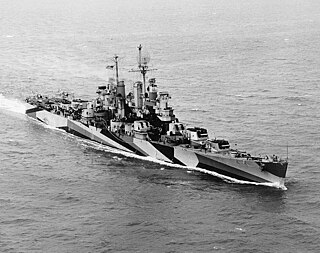
USS Duluth was a Cleveland-class light cruiser of the United States Navy, which were built during World War II. The class was designed as a development of the earlier Brooklyn-class cruisers, the size of which had been limited by the First London Naval Treaty. The start of the war led to the dissolution of the treaty system, but the dramatic need for new vessels precluded a new design, so the Clevelands used the same hull as their predecessors, but were significantly heavier. The Clevelands carried a main battery of twelve 6-inch (152 mm) guns in four three-gun turrets, along with a secondary armament of twelve 5 in (127 mm) dual-purpose guns. They had a top speed of 32.5 knots.

The Northampton-class cruisers were a group of six heavy cruisers built for the United States Navy, and commissioned between 1928 and 1931.

USS Dayton was a Cleveland-class light cruiser of the United States Navy, which were built during World War II. The class was designed as a development of the earlier Brooklyn-class cruisers, the size of which had been limited by the First London Naval Treaty. The start of the war led to the dissolution of the treaty system, but the dramatic need for new vessels precluded a new design, so the Clevelands used the same hull as their predecessors, but were significantly heavier. The Clevelands carried a main battery of twelve 6-inch (152 mm) guns in four three-gun turrets, along with a secondary armament of twelve 5 in (127 mm) dual-purpose guns. They had a top speed of 32.5 knots.
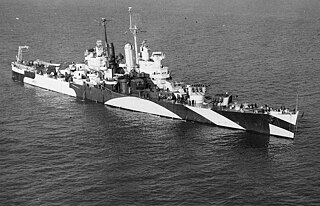
USS Houston (CL-81) was a Cleveland-class light cruiser of the United States Navy, which were built during World War II. The class was designed as a development of the earlier Brooklyn-class cruisers, the size of which had been limited by the First London Naval Treaty. The start of the war led to the dissolution of the treaty system, but the dramatic need for new vessels precluded a new design, so the Clevelands used the same hull as their predecessors, but were significantly heavier. The Clevelands carried a main battery of twelve 6-inch (152 mm) guns in four three-gun turrets, along with a secondary armament of twelve 5 in (127 mm) dual-purpose guns. They had a top speed of 32.5 knots.

The Alaska class were six very large cruisers ordered before World War II for the United States Navy, of which only two were completed and saw service late in the war. The US Navy designation for the ships of this class was 'large cruiser' (CB) and the majority of leading reference works consider them as such. However, various other works have alternately described these ships as battlecruisers despite the US Navy having never classified them as such. The Alaskas were all named after territories or insular areas of the United States, signifying their intermediate status between larger battleships and smaller heavy and light cruisers.
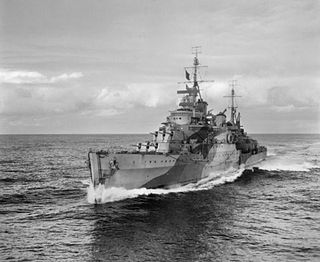
The Town class consisted of 10 light cruisers built for the Royal Navy during the 1930s. The Towns were designed to the constraints imposed by the London Naval Treaty of 1930. The ships were built in three distinct sub-classes, the Southampton, Gloucester and Edinburgh classes respectively, each sub-class adding on further weaponry.

USS Columbia was a Cleveland-class light cruiser of the United States Navy, which were built during World War II. The class was designed as a development of the earlier Brooklyn-class cruisers, the size of which had been limited by the First London Naval Treaty. The start of the war led to the dissolution of the treaty system, but the dramatic need for new vessels precluded a new design, so the Clevelands used the same hull as their predecessors, but were significantly heavier. The Clevelands carried a main battery of twelve 6-inch (152 mm) guns in four three-gun turrets, along with a secondary armament of twelve 5 in (127 mm) dual-purpose guns. They had a top speed of 32.5 knots.

USS Portsmouth was a Cleveland-class light cruiser of the United States Navy, which were built during World War II. The class was designed as a development of the earlier Brooklyn-class cruisers, the size of which had been limited by the First London Naval Treaty. The start of the war led to the dissolution of the treaty system, but the dramatic need for new vessels precluded a new design, so the Clevelands used the same hull as their predecessors, but were significantly heavier. The Clevelands carried a main battery of twelve 6-inch (152 mm) guns in four three-gun turrets, along with a secondary armament of twelve 5 in (127 mm) dual-purpose guns. They had a top speed of 32.5 knots. Portsmouth was laid down in 1943, launched in September 1944, and commissioned in June 1945. By the time she completed her initial sea trials, the war had ended, so her career was short and uneventful. She made three overseas cruises to visit ports in Africa and the Mediterranean Sea between 1946 and 1948 before conducting training cruises later in 1948. The following year, she was decommissioned and assigned to the Atlantic Reserve Fleet, where she remained until 1970, when she was broken up.
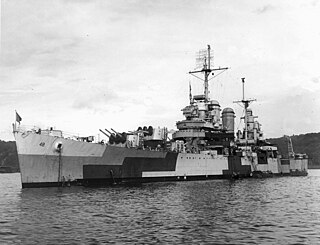
The Brooklyn-class cruiser was a class of nine light cruisers built for the United States Navy between 1935 and 1938. Armed with five triple 6-inch (152 mm) gun turrets, they mounted more main battery guns than any other standard US cruiser. The Brooklyn-class ships were all commissioned between 1937 and 1939, in the time between the start of the Second Sino-Japanese War and before the invasion of Poland. They served extensively in both the Pacific and Atlantic theaters during World War II.

The Cleveland class was a group of light cruisers built for the U.S. Navy during World War II. They were the most numerous class of light cruisers ever built. Fifty-two were ordered, and 36 were completed, 27 as cruisers and nine as light aircraft carriers. They were deactivated within a few years after the end of the war, but six were converted into missile ships, and some of these served into the 1970s. One ship of the class remains as a museum ship.

Takao (高雄) was the lead vessel in the Takao-class heavy cruisers, active in World War II with the Imperial Japanese Navy. These were the largest cruisers in the Japanese fleet, and were intended to form the backbone of a multipurpose long-range strike force. Her sister ships were Atago, Maya and Chōkai.

The Oregon City class was a class of heavy cruisers of the United States Navy. Although ten ships of this class were planned, only four were completed – one of those as a command ship. The three ships completed as cruisers were in commission from 1946 to 1980, one having been converted to a guided missile cruiser (CG).
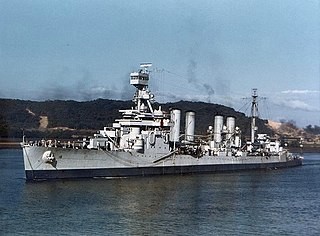
The Omaha-class cruisers were a class of light cruisers built for the United States Navy. They were the oldest class of cruiser still in active service with the Navy at the outbreak of World War II, being an immediate post-World War I design.
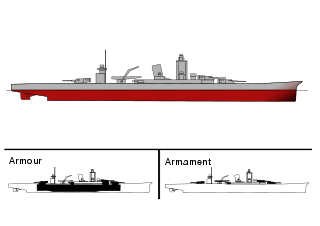
Design B-65 was a class of Super Type A cruisers planned by the Imperial Japanese Navy (IJN) before and during World War II. As envisioned by the IJN, the cruisers were to play a key role in the Night Battle Force portion of the "Decisive battle" strategy which Japan hoped, in the event of war, to employ against the United States Navy.

The Kuma-class light cruisers were a class of five light cruisers built for and operated by the Imperial Japanese Navy (IJN). The Kuma-class cruisers proved useful in combat operations ranging from the Aleutian Islands to the Indian Ocean throughout World War II.

The six Nagara-class light cruisers were a class of six light cruisers built for and operated by the Imperial Japanese Navy. The Nagara-class cruisers proved useful in combat operations ranging from the Aleutian Islands to the Indian Ocean throughout World War II. Most served as flagships for destroyer or submarine squadrons, and were deployed for transport or local defense missions. Towards the end of the war, the surviving vessels were increasingly obsolete and were retained as second-line units.

The Aoba-class cruisers were a class of two heavy cruisers constructed for the Imperial Japanese Navy (IJN) which saw service during World War II.
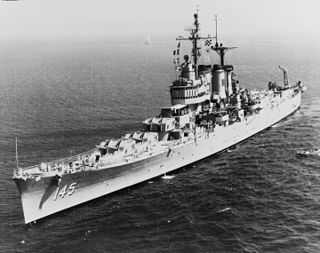
The Worcester class was a class of light cruisers used by the United States Navy, laid down in 1945 and commissioned in 1948–49. They and their contemporaries, the Des Moines-class heavy cruisers, were the last all-gun cruisers built for the U.S. Navy. Ten ships were planned for this class, but only two were completed.

The Juneau-class cruisers were United States Navy light cruisers that were modified version of the Atlanta-class cruiser design. The ships had the same dual-purpose main armament as USS Oakland with a much heavier secondary antiaircraft battery, while the anti-submarine depth charge tracks and torpedo tubes were removed along with a redesigned superstructure to reduce weight and increase stability. Three ships were ordered and built, all completed shortly after World War II, but only Juneau remained active long enough to see action during the Korean War.

The CL-154 class of 5-inch (127 mm) gun light cruisers was a United States Navy project from the last two years of World War II, with antecedents reaching back to 1938 and earlier. The CL-154 class was contemporary to the 6-inch (152 mm) gun Worcester-class light cruisers and the 8-inch (203 mm) gun Des Moines-class heavy cruisers: like them the CL-154 design incorporated the lessons learned of World War II combat. The Navy allocated six hull numbers to the CL-154 class for the planned construction, but unlike the Worcester and Des Moines classes the CL-154 class would be cancelled with no units named or constructed. Had these ships been built, they would have been given the hull classification CLAA on 18 March 1949.




















